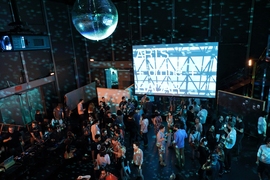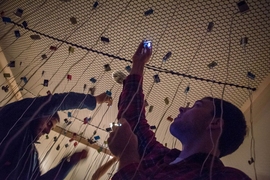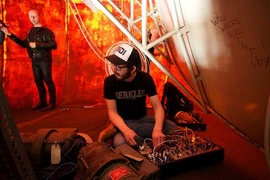In August 1952 at Black Mountain College in Asheville, North Carolina, the composer John Cage staged a historic performance entitled "Theater Piece No. 1 (Black Mountain Piece)."
Unlike conventional theater, in which action takes place in the center or on a stage, Cage’s event distributed movement, music, and other activities throughout a space and without a rigid script. There were no rehearsals or recordings, and recollections of the evening differ, but the event — later known as the first “Happening” — is now considered a seminal moment in the history of art.
This fall, four students from MIT are performing a series of experimental “actions” at Boston's Institute of Contemporary Art (ICA), inspired by “Leap Before You Look: Black Mountain College 1933–1957,” a current exhibition that celebrates the legacy of the college and its influence on contemporary culture.
The four students are enrolled in the Performing Arts Workshop (PAW), an MIT course being taught this semester by Kelly Nipper, a lecturer in the MIT Program in Art, Culture, and Technology (ACT). Nipper was one of five Boston-based artists invited by the ICA to participate in live performances to accompany the exhibition, but she asked the ICA if her students could take the spotlight instead.
“The course focuses on process — the tacit, embodied, and intrinsic act of doing as expression and practice by blurring the divide between art and production,” Nipper says.
Nipper’s decision, which the ICA backed, reflects the pedagogy that Black Mountain College was known for. Though short-lived, the small, experimental school in the Blue Ridge Mountains of North Carolina is famous for a progressive educational approach that replaced rote memorization with critical thinking and risk-taking and encouraged faculty and students to engage robustly with each other. The faculty included some of the most influential artists, musicians, poets, and thinkers of the time, including Merce Cunningham, Josef Albers, and Buckminster Fuller.
Drawing from history — and each other
The performances by the MIT students and the four other Boston artists invited by the ICA are called "Theater Piece No. 1 x 50," a series of actions that will take place in November and December in the ICA galleries and throughout the museum.
The students — undergraduate Andre Aboulian and graduate students Jessika Khazrik, Jose Rivera, and Björn Sparrman — will draw not only from history, but also from their own and each other’s unique talents and experiences for 10 live performances.
A full schedule of MIT performances at the ICA is listed on the ACT website.
Collaboration across the arts and sciences
During a recent morning, Aboulian sat on the floor of the ICA’s cavernous, sun-filled lobby, employing hand tools to pull apart discarded electronics — a bar-code scanner, a server power supply, a CD drive — then energizing their internal components individually. On the other side of the box sat Rivera, who amplified, mixed, and transformed the sounds of these elements, as well as those emitted from the process of deconstruction. What started as whirs and taps soon resembled the roar of waves and thunder coming from overhead.
“This is in line with the Black Mountain College and MIT ethos of learning by doing. Experimentation is part of that process, which I think is consistent with any art or science endeavor,” Rivera says.
In an earlier piece, Sparrman moved through a room rearranging pots that he had made, while Rivera mapped his movement over time and then hand-wrote and performed a musical score base on Sparrman’s movements.
“It’s really nice to be able to do things that are indeterminate or unknown,” Sparrman says. “I think it’s very rare for students to get an opportunity like this.”
The performances often bring together distinct perspectives. For example, Rivera is a graduate student with a background in architecture and sound, while Aboulian is a senior majoring in electrical engineering and computer science. “This is the thing about ACT,” Nipper says. “It is an experimental artistic community that like Black Mountain College prioritizes practice before theory, experience before knowledge, and search before research.”
A school becomes a classroom
The chance nature of the performances is one of their most compelling aspects, says ICA Assistant Curator Ruth Erickson, who works closely with the PAW students, visiting them in their classroom at MIT to brainstorm their performances, hosting them at the ICA for a sneak preview of the exhibit, and peppering them with questions after their performances.
“I love the idea of an exhibit about a school becoming a classroom,” Erickson says.









